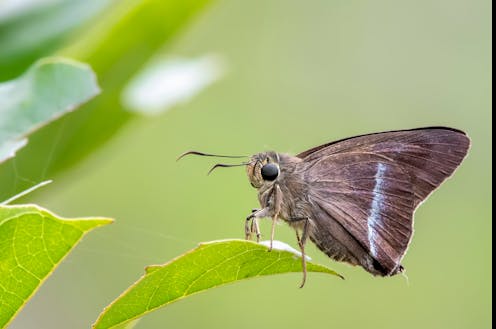a new 'family tree' traces their 100-million-year journey across the globe
- Written by Michael F. Braby, Associate Professor, Australian National University

How old are butterflies, and where did they evolve? And perhaps more importantly, how and when did they reach the isolated continent of Australia?
Answers to these simple questions have baffled scientists for decades. Until recently we had very little idea when butterflies evolved, and hypotheses concerning their place of origin were largely educated guesses.
In recent years, however, several studies have indicated butterflies most likely arose sometime during the Cretaceous period, when dinosaurs dominated the Earth. Now, an international collaboration (of which I am a member) has placed the time of origin much more precisely[1]: 101.4 million years ago, give or take 1.2 million years.
These early butterflies were different from nocturnal moths, their ancestors. They flew during the day, rather than at night, and were attracted to brightly coloured flowers for their rich nectar.
A 100-million-year history
To reach this conclusion, researchers from dozens of countries needed to construct the world’s largest “family tree” of butterfly species. This tree of life was assembled with DNA from 2,244 species representing all butterfly families and 92% of genera.
There are roughly 19,000 butterfly species in the world, and piecing together the 100-million-year history of the group required assembling the world’s largest dataset of butterfly DNA sequences, geographical distributions and larval host plants.
Underlying the analysis were 11 rare butterfly fossils, without which the analysis would have been impossible. Butterflies are rarely preserved in the fossil record, and those that are preserved are frequently difficult to identify.
These fossils served as calibration points on the evolutionary tree. Once the tree was calibrated researchers could then estimate the timing of key events in butterfly evolution, starting with their origin.
North American origins
Not only did this latest study determine the age of butterflies, it also discovered where the butterflies first originated. By assembling a database of the distributions of all modern species and the plants on which they lay their eggs, the scientists were able to trace the movements of butterflies through time and space.
The study tells a dynamic story – one rife with rapid diversifications, faltering advances, and improbable dispersals. Some groups travelled over what seem impossibly vast distances, and others seem to have stayed in one place while continents, mountains and rivers moved around them.
According to this latest research, butterflies first appeared somewhere in Central and western North America.
At that time in the mid-Cretaceous, the continent of North America was part of eastern Laurasia, and it was bisected by an expansive seaway that split the continent in two. Present-day Mexico was joined in a long arc with what is now the United States, Canada and Russia.
North and South America had not yet joined via the isthmus of Panama, but butterflies seem to have had little difficulty crossing the water gap into the Southern Hemisphere. Once they reached South America, the early butterflies diversified to an astonishing degree.

















